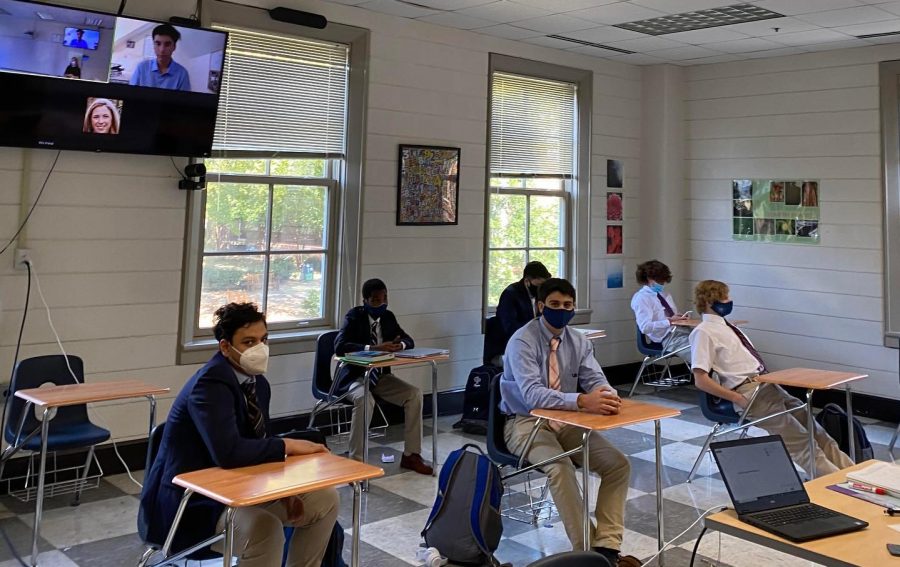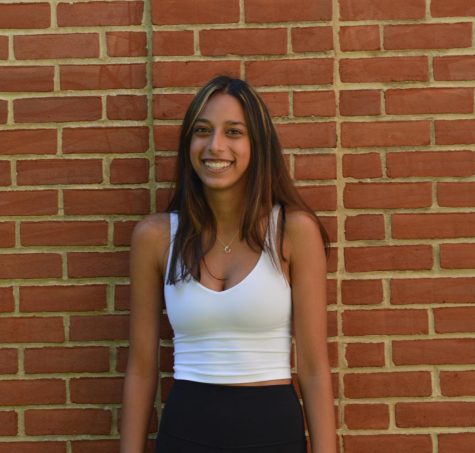Maryland should prioritize public schools in the midst of a pandemic
Photo courtesy of Georgetown Prep
A classroom at Georgetown Preparatory School, where students may receive in-person learning. Many private schools are opening using state funds, while public schools are left completely virtual.
October 22, 2020
Two students from the same neighborhood: they’re in the same grade, take the same number of accelerated courses, strive for the same dream school. There’s only one difference: money. The wealthier family can afford to pay thousands of dollars to send their child to a private school that offers a full week of learning, including some in-person. The less financially stable family cannot provide their child with the same opportunities. Their child has to remain in public school with a virtual classroom and reduced learning hours. This isn’t just some far-fetched hypothetical; it’s happening to real families all over Montgomery County.
Allowing private schools to open while public schools are mandated to stay closed exacerbates socio-economic education disparities by providing wealthier families better access to education. This widening achievement gap has long-lasting implications for students and their educational development. Maryland should focus on providing support to public schools to improve virtual learning and facilitate a safe return back to the classroom, rather than focusing their attention and resources on private schools.
Over the summer, MCPS announced that the first semester of the school year would be exclusively virtual. Necessary materials would be distributed to properly engage students in online learning, including Chromebooks and WiFi hotspots. However, even though students received school supplies, the virtual schedule drastically cut class time. The current virtual schedule only provides 14 instructional hours per week. By contrast, pre-pandemic in-person learning provided 26 instructional hours, allotting an additional 12 hours for education.
On the other hand, private schools like Holton Arms, located just down the street from Whitman, have the same virtual hours as they would in person, with more than 25 hours of learning a week.
Monelli Esfandiary, a senior at Holton Arms, said that the schedule is the same as if they were in person, with learning from 8:15–3:30 every day. Private school students simply receive more time for academics than MCPS students. This creates a disparity between public and private school attendees, which would only be further exacerbated if private schools returned to in-person learning while public schools remained virtual.
Every student should have equal access to education to ensure that the playing fields are level. When the county only allowed private schools to return to in-class learning, they also allowed their public school students to fall behind in the curriculum. An educational leg up widens the county’s equity gap, ensuring that low-income students receive a worse standard of education compared to well-off peers.
Many private schools are using more than just tuition fees and donations to supplement the hefty cost of classroom safety; they are also using funding from the Maryland government. Under the state’s Paycheck Protection Program, private schools in Maryland received a total of $110 million dollars in loans. The same Larry Hogan who bowed down to the cries of private school parents — all while Montgomery County Health Officer Dr. Gayles announced that conditions were not safe enough for private schools to reopen — has remained silent when it comes to returning public schools to a pre-pandemic state of normalcy. He has failed to provide grants to upgrade public schools’ HVAC and ventilation systems that would help ensure a safe return to in-person learning. The state and federal governments’ education priorities during the pandemic should lie with public education rather than with a select group of predominantly wealthy families who can bypass the system.
“What I can say is this: for public schools to reopen safely we need the resources to do so,” said Patti Mullins, Press Secretary and research specialist for the Maryland State Education Association. “Instead of getting those resources, we have seen federal inaction and attempted cuts from the governor as he continues undercutting our schools.”
Public school is the educational backbone of our country; a majority of students countywide, statewide and nationwide attend public schools. The failure to adequately fund public schools during this time jeopardizes a critical institution, as demonstrated by a decline in enrollment in MCPS since the start of the pandemic.
If private schools are not required to follow county reopening guidelines, they should not be eligible for state funding. This inherent hypocrisy highlights the public-private school disconnect, especially as the former loses funding to the tune of 2.9 billion dollars in Maryland alone.
Some students are receiving a proper, in-person education and some are not. The only variable is how much one students’ family is willing to pay to get ahead. Instead of attempting to close the equity gap between Maryland students, Governor Hogan has opened the floodgates. Only a select few children have an opportunity to receive a full week’s worth of education, and unfortunately, the sole determinant is how much parents are able to afford in the midst of a recession. The long-term consequences of favoring wealthier students will have severe effects, many of which cannot yet be fully anticipated. A vast majority of students receive public education, yet a vast majority of the county’s resources are funneled into private schools. This favoritism puts the futures of hundreds of thousands of students at stake.










Richard Fidler • Oct 23, 2020 at 2:12 am
Two points: The parents of students who have switched from MCPS to private schools (as our granddaughters have done) still pay property taxes to the county and at least half of that tax revenue supports public schools (at $15K per student annually). So while the parents are paying thousands of dollars in property taxes, they aren’t getting the direct benefits. That means that the public schools have more money to spend on a decreased level of students.
Also, MCPS has known for seven months that they would eventually have to reopen the schools but they have yet to produce a plan.